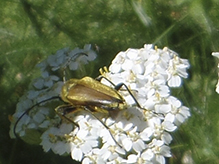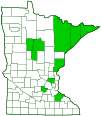Yellow velvet beetle
(Lepturobosca chrysocoma)
Conservation • Description • Habitat • Ecology • Distribution • Taxonomy
Conservation Status |
|||
| IUCN Red List | not listed |
||
| NatureServe | NNR - Unranked |
||
| Minnesota | not listed |
||
Description |
Yellow velvet beetle, also called golden flower longhorn beetle, is a tapered, small to medium-sized, flower longhorn beetle. It occurs in North America west of the Great Plains from Alaska to New Mexico, in southern Canada from Nova Scotia to Manitoba, and in the northern United States in Maine, northern Michigan, northern Wisconsin, and eastern Minnesota. It is uncommon in Minnesota. Larvae feed on the decaying wood of pine, spruce, alder, and aspen. Adults are found on flowers in the summer. Adults are ⅜″ to ¾″ (10 to 20 mm) long. The body is strongly tapered toward the rear. It is covered with long, golden-yellow hairs, though this is not visible from above. The head is angled forward in front and is abruptly constricted in back forming a neck that is visible when viewed from above. It is mostly black except for the yellow mouth parts. The compound eyes are large, black, and deeply notched. The antennae are thread-like, slender, entirely black, and long, about as long as the body. The base of each antenna is inserted in the notch in the compound eye. All antennal segments are uniformly slender. The third segment is much longer than the first (scape), the fourth is shorter than the third, and the fifth is longer than the fourth. The neck is black. The upper part of the face (frons) and the top of the head (vertex) are moderately covered with long golden-yellow hairs that lie flat. The upper thoracic shield (pronotum) is bell-shaped, arched, and narrow at the front. It is not as wide at the base as the base of the hardened wing covers (elytra). It is black and is covered with long, golden-yellow hairs. The elytra are long and narrow, more than 2½ times longer than wide. They taper evenly from the broad base to the narrow tip, making the body appear broad-shouldered. They are usually yellow, sometimes with a brownish or blackish tinge. They are usually densely covered with short, yellow hairs. The hairs lie flat and are directed away from the inner margin (suture). The legs are slender and densely covered with fine yellow hairs. The third segment (femur) of each leg is black. The fourth segment (tibia) is brownish-yellow and has a spur at the tip. The last part of each leg (tarsus), corresponding to the foot, is brownish-yellow. The tarsus has five segments but the fourth segment is minute and is concealed within the lobes of the heart-shaped third segment, making it appear that there are only four segments. On the hind leg, the tarsi are slender. The first segment is as long as all of the remaining segments together. The third segment is split beyond the middle. |
Size |
Total length: ⅜″ to ¾″ (10 to 20 mm) |
Similar Species |
Habitat |
Woodlands |
Ecology |
Season |
Summer |
Behavior |
|
Life Cycle |
|
Larva Food |
Decaying wood of hardwoods and conifers |
Adult Food |
Flower nectar |
Distribution |
||
|
Sources |
|
| 9/22/2025 | ||
Occurrence |
||
|
||
Taxonomy |
|
Order |
Coleoptera (Beetles) |
Suborder |
Polyphaga (Water, Rove, Scarab, Long-horned, Leaf, and Snout Beetles) |
Infraorder |
Cucujiformia |
Superfamily |
Chrysomeloidea (leaf beetles and allies) |
Family |
Cerambycidae (longhorn beetles) |
Subfamily |
Lepturinae (flower longhorn beetles) |
Tribe |
Lepturini |
Genus |
Lepturobosca |
|
|
Superfamily Genus |
|
Subordinate Taxa |
|
|
|
Synonyms |
|
Cosmosalia aureola Cosmosalia auripilis Cosmosalia auripilis densepilosa Cosmosalia chrysocoma |
|
Common Names |
|
golden flower longhorn beetle yellow velvet beetle |
|
Glossary
Elytra
The hardened or leathery forewings of beetles used to protect the fragile hindwings, which are used for flying. Singular: elytron.
Femur
On insects and arachnids, the third, largest, most robust segment of the leg, coming immediately before the tibia. On humans, the thigh bone.
Frons
The upper front part of an insect’s face, roughly corresponding to the forehead.
Pronotum
The exoskeletal plate on the upper side of the first segment of the thorax of an insect.
Scape
In plants: An erect, leafless stalk growing from the rootstock and supporting a flower or a flower cluster. In insects: The basal segment of the antenna.
Tarsus
On insects, the last two to five subdivisions of the leg, attached to the tibia; the foot. On spiders, the last segment of the leg. Plural: tarsi.
Tibia
The fourth segment of an insect leg, after the femur and before the tarsus (foot). The fifth segment of a spider leg or palp. Plural: tibiae.
Vertex
The upper surface of an insect’s head.
Visitor Photos
Share your photo of this insect.
This button not working for you?
Simply email us at info@MinnesotaSeasons.com.
Attach one or more photos and, if you like, a caption.
Luciearl |
 |
This beetle spent a couple of days on the same yarrow. |
MinnesotaSeasons.com Photos
|

Slideshows

Visitor Videos
Share your video of this insect.
This button not working for you?
Simply email us at info@MinnesotaSeasons.com.
Attach a video, a YouTube link, or a cloud storage link.
Other Videos



